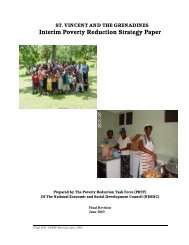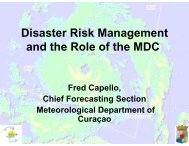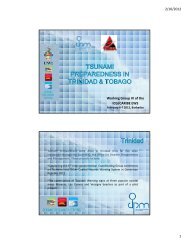The Anatomy of A Silent Crisis The Anatomy of A Silent Crisis
The Anatomy of A Silent Crisis The Anatomy of A Silent Crisis
The Anatomy of A Silent Crisis The Anatomy of A Silent Crisis
- TAGS
- anatomy
- www.bb.undp.org
You also want an ePaper? Increase the reach of your titles
YUMPU automatically turns print PDFs into web optimized ePapers that Google loves.
End Notes<br />
1. <strong>The</strong>se parameters include global mean surface<br />
temperature, sea-level rise, ocean and ice sheet<br />
dynamics, ocean acidification, and weather related<br />
disasters.<br />
2. Food Security refers to the availability <strong>of</strong> food and<br />
people’s access to it. A household is food secure when<br />
its occupants do not live in hunger or fear <strong>of</strong> starvation.<br />
3. Report team calculation — see “Notes on report<br />
methodology” for further explanation.<br />
4. McMichael, A.J., et al (2004): “Chapter 20: Global<br />
Climate Change” in Comparative Quantification <strong>of</strong><br />
Health Risks. World Health Organization.<br />
5. Kron, W. (2009): “Flood insurance: from clients to global<br />
financial markets.”, Journal <strong>of</strong> Flood Risk Management,<br />
2 68-75, Geo Risks Research, Munich Reinsurance<br />
Company, Koeniginstrasse, Munich, Germany.<br />
6. CRED and ISDR (2008): “2008 Disasters in Numbers.”<br />
International Strategy for Disaster Reduction<br />
and Centre for Research on the Epidemiology <strong>of</strong><br />
Disasters, p.1-2.<br />
7. Based on definition by Centre for Research on the<br />
Epidemiology <strong>of</strong> Disasters (CRED) database.<br />
8. WHO estimates that 24.3 million people were<br />
seriously injured in road traffic accidents and required<br />
medical attention in 2004. WHO. (2004): “<strong>The</strong> global<br />
burden <strong>of</strong> disease: 2004 update.” World Health<br />
Organization Health statistics and health information<br />
systems, p.28. http://www.who.int/healthinfo/global_<br />
burden_disease/2004_report_update/en/index.html.<br />
9. WHO estimates that 247 million cases <strong>of</strong> Malaria were<br />
recorded in 2006. WHO. (2008): “World Malaria Report<br />
2008.” World Health Organization. http://apps.who.int/<br />
malaria/wmr2008/.<br />
10. Attribution <strong>of</strong> climate change includes efforts to<br />
scientifically ascertain mechanisms responsible for<br />
relatively recent changes observed in the Earth’s<br />
climate, i.e. variations in temperature, weather<br />
97<br />
related disasters and disease levels. <strong>The</strong> dominant<br />
mechanisms include manmade activities increasing<br />
greenhouse gases, aerosols, and land surface changes<br />
like deforestation.<br />
11. Dr. Baines from the University <strong>of</strong> Melbourne estimates<br />
that 37% <strong>of</strong> drought is caused by climate change in 6<br />
regions <strong>of</strong> the world. Baines, P. (2009): “<strong>The</strong> attribution<br />
<strong>of</strong> causes <strong>of</strong> current decadal droughts.” University <strong>of</strong><br />
Melbourne and Fogarty, D. (2009): “Global warming<br />
37 pct to blame for droughts-scientist.” Reuters,<br />
March 25. http://www.reuters.com/article/latest<strong>Crisis</strong>/<br />
idUSSP141565.<br />
12. <strong>The</strong> calculation and the assumptions are detailed in<br />
“Notes on report methodology.”<br />
13. <strong>The</strong> Indian Ocean Earthquake in 2004 killed over<br />
225,000 people.<br />
14. Includes Malnutrition, Diarrhoea, and Malaria. Please<br />
refer to “Notes on report methodology C.”<br />
15. Tin, T. Dr. (2007): “Climate Change: Faster, Sooner,<br />
Stronger. An Overview <strong>of</strong> the Climate Science<br />
Published Since the Fourth IPCC Assessment Report”.<br />
World Wildlife Foundation, WWF and Allan, R., and<br />
Soden, B. (2008): “Atmospheric warming and the<br />
amplification <strong>of</strong> precipitation extremes.” Science.<br />
September 12, Volume 32, Number. 5895, DOI:<br />
10.1126/science.1160787.<br />
16. Kundzewicz, Z.W., et al. (2007): “Freshwater resources<br />
and their management.” Climate Change 2007:<br />
Impacts, Adaptation and Vulnerability, Contribution <strong>of</strong><br />
Working Group II to the Fourth Assessment Report<br />
<strong>of</strong> the Intergovernmental Panel on Climate Change,<br />
M.L. Parry, et al. Eds., Cambridge University Press,<br />
Cambridge, UK, 173-210.<br />
17. International Strategy for Disaster Reduction Statistics,<br />
(2008) and Munich Re Statistics, (2009).<br />
18. According to CRED, 219 million on average required<br />
assistance between 2000 and 2008 and 40% is attributed







